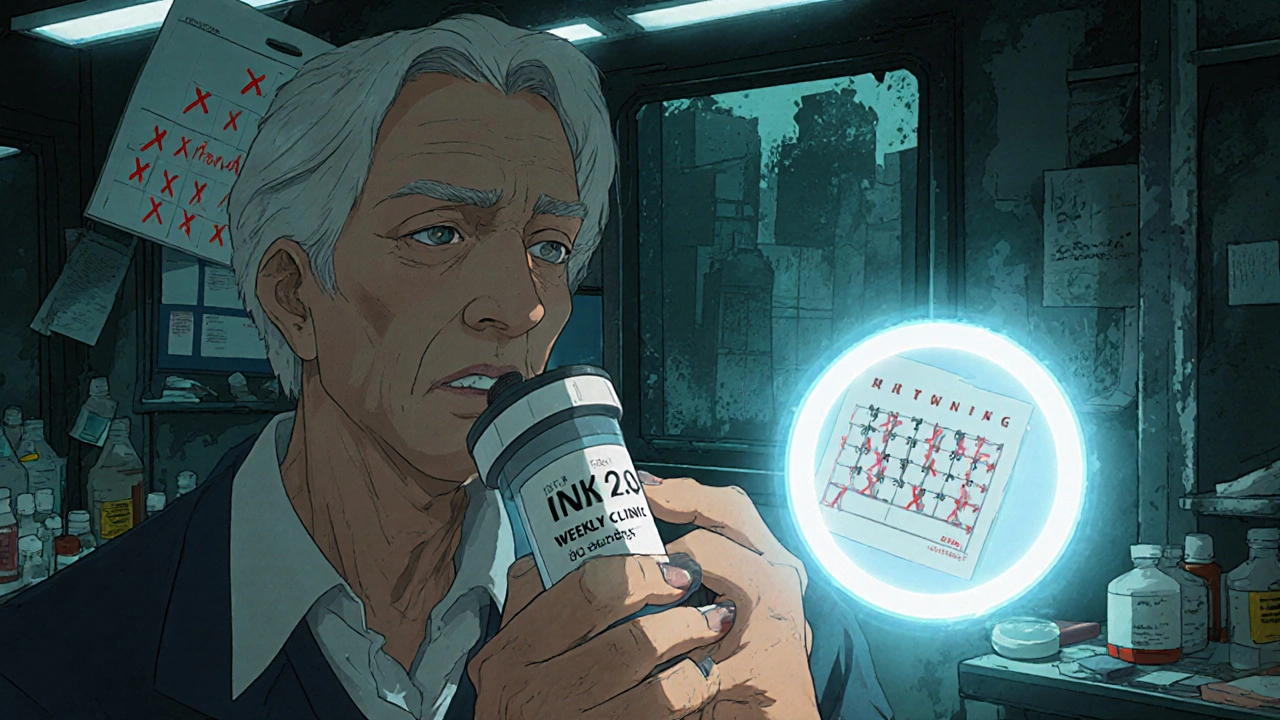Choosing a blood thinner isn’t just about following a doctor’s order - it’s about understanding what’s safest for your body, lifestyle, and risks. For millions of people with atrial fibrillation, deep vein thrombosis, or mechanical heart valves, the choice comes down to two main options: warfarin or one of the newer direct oral anticoagulants (DOACs) like apixaban, rivaroxaban, or dabigatran. Both work to prevent deadly clots, but their safety profiles couldn’t be more different.
Why Warfarin Still Exists - and Who Should Stay on It
Warfarin has been around since the 1950s. It’s cheap, well-studied, and works by blocking vitamin K, which your body needs to make clotting factors. But that same mechanism makes it unpredictable. One day you eat a big salad, the next you’re on antibiotics, and suddenly your INR (a blood test that measures clotting time) spikes or drops. That’s why you need frequent blood tests - often every week or two - to keep your INR between 2.0 and 3.0. Too low, and you risk a stroke. Too high, and you could bleed internally.Despite its hassle, warfarin isn’t obsolete. If you have a mechanical heart valve, warfarin is your only safe option. DOACs can cause dangerous clots on these valves. The same goes for people with severe kidney failure (eGFR below 15 mL/min). DOACs build up in the blood when kidneys can’t clear them, increasing bleeding risk. For these groups, warfarin remains the gold standard - even with its quirks.
Why DOACs Are Now the First Choice for Most People
Direct oral anticoagulants - or DOACs - changed the game. They don’t need INR checks. You take the same dose every day, no matter what you eat or what other meds you’re on. Apixaban (Eliquis), rivaroxaban (Xarelto), dabigatran (Pradaxa), and edoxaban (Savaysa) target specific clotting factors directly. That makes them more consistent and, in most cases, safer.A 2023 study in JAMA Network Open found DOACs reduced the risk of major bleeding by 30% compared to warfarin. Intracranial bleeding - the most dangerous kind - dropped by over 50%. For people with atrial fibrillation, DOACs lowered stroke risk by 30% too. These aren’t small gains. They’re life-changing.
Apixaban stands out in the group. Multiple studies show it causes fewer serious bleeds than rivaroxaban or dabigatran. One analysis found apixaban users had a 25% lower risk of major bleeding than those on rivaroxaban. For older adults or those with a history of falls, that difference matters.
How Kidney Function Changes the Game
Your kidneys don’t just filter waste - they clear your blood thinners. This is where DOACs get complicated. Dabigatran is cleared 80% by the kidneys. If your eGFR drops below 30, your doctor might switch you to warfarin. Apixaban, on the other hand, is cleared mostly by the liver. Only 27% passes through the kidneys. That’s why apixaban is often the go-to for people with moderate kidney disease.But here’s the catch: if your kidney function is below 25 mL/min, even apixaban becomes riskier. A 2023 study showed that for every 10-point drop in eGFR, the risk of brain bleeding increased more with DOACs than with warfarin. That’s why guidelines now say: if your kidneys are severely damaged, stick with warfarin - unless you’re on dialysis. Even then, data is limited, and many doctors still prefer warfarin.

The Cost Factor - And Why It’s Not Just About Price
Warfarin costs about $4 for a 30-day supply. Apixaban? Around $587. Rivaroxaban? Over $520. That’s a huge gap. But cost isn’t just the sticker price. Warfarin requires 6-12 blood tests in the first month, then 2-4 per month. Each test costs $20-$50. Add in clinic visits, time off work, and the stress of managing your levels, and the real cost climbs fast.DOACs eliminate that. No blood draws. No dietary restrictions. No guessing. A 2023 study in the American Journal of Managed Care found DOAC users had 32% higher adherence rates than warfarin users. Among people under 45, adherence jumped 41%. That’s not just convenience - it’s safety. Missing a warfarin dose or skipping an INR test can lead to a stroke. Missing a DOAC dose? Risk is lower, but still real.
What Happens If You Bleed? Reversal Agents Matter
Bleeding is the biggest fear with any anticoagulant. With warfarin, you can reverse it with vitamin K or fresh frozen plasma - but it takes hours. DOACs used to be irreversible. Now, we have specific antidotes.Idarucizumab (Praxbind) reverses dabigatran in minutes. Andexanet alfa (Andexxa) reverses apixaban and rivaroxaban. These aren’t available everywhere, and they’re expensive - but they exist. That’s a massive upgrade. If you’re in a car accident or need emergency surgery, knowing there’s a fast way to stop the bleeding gives patients and doctors real peace of mind.
Real People, Real Choices
On patient forums, the pattern is clear. People on DOACs say they feel freer. No more counting spinach. No more rushing to the lab before vacation. One Reddit user wrote: “I went on a two-week hiking trip in the Rockies. With warfarin, I’d have been terrified. With apixaban? I just packed my pills and went.”But not everyone feels that way. People with mechanical valves often say warfarin gives them control. “I know my numbers. I know what’s happening,” one patient told a support group. “With DOACs, it’s like flying blind.”
And then there’s cost. A 68-year-old on Medicare in rural Iowa told a nurse: “I can’t afford $600 a month. I’d rather get my INR checked every week if it means I can live.” For some, warfarin isn’t outdated - it’s essential.

When DOACs Aren’t the Answer
DOACs are better for most - but not all. Avoid them if you:- Have a mechanical heart valve
- Have severe kidney disease (eGFR <15)
- Are pregnant or breastfeeding
- Have antiphospholipid syndrome with prior clots (warfarin is still preferred)
- Have mitral stenosis (narrowed heart valve)
And if you’re on a DOAC, never skip a dose. Unlike warfarin, there’s no safety net. Missing a pill for more than 24 hours increases clot risk - especially in the first few days.
What Your Doctor Should Check Before Prescribing
If you’re starting a blood thinner, your doctor should do more than just write a prescription. They need to know:- Your exact kidney function (eGFR, not just “kidneys are fine”)
- All your other medications - even over-the-counter ones like ibuprofen or fish oil
- Your weight - low body weight increases bleeding risk with DOACs
- Your history of bleeding or falls
- Whether you can afford the medication
And they should talk to you about what happens if you miss a dose, if you fall, or if you need surgery. This isn’t a set-it-and-forget-it drug. It’s a lifelong commitment - and you need to understand it.
The Future of Blood Thinners
New drugs are coming. One trial is testing a pill that combines warfarin with vitamin K to stabilize INR levels. Another, called AUGUSTUS-CKD, is studying apixaban vs. warfarin in patients with advanced kidney disease - results expected in late 2024. If those trials show DOACs are safe even in dialysis patients, that could change everything.But for now, the message is clear: for most people with atrial fibrillation or a history of blood clots, DOACs are safer, easier, and more effective. Warfarin isn’t outdated - it’s specialized. It’s the tool for the job when DOACs can’t be used.
The best anticoagulant isn’t the newest one. It’s the one that fits your life, your body, and your risks - without making you choose between safety and sanity.

Stephen Adeyanju
November 26, 2025 AT 13:29mohit passi
November 26, 2025 AT 16:53Sanjay Menon
November 26, 2025 AT 18:50Cynthia Springer
November 27, 2025 AT 21:12Brittany Medley
November 28, 2025 AT 02:20Marissa Coratti
November 29, 2025 AT 05:32Rachel Whip
November 30, 2025 AT 10:10Ezequiel adrian
December 2, 2025 AT 05:20